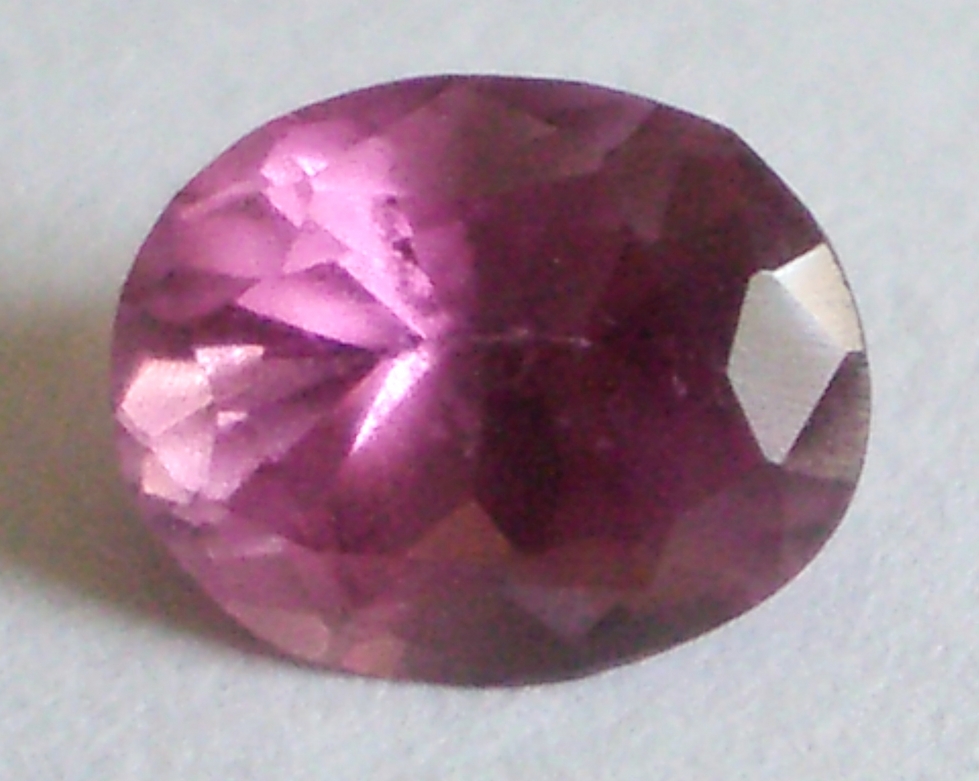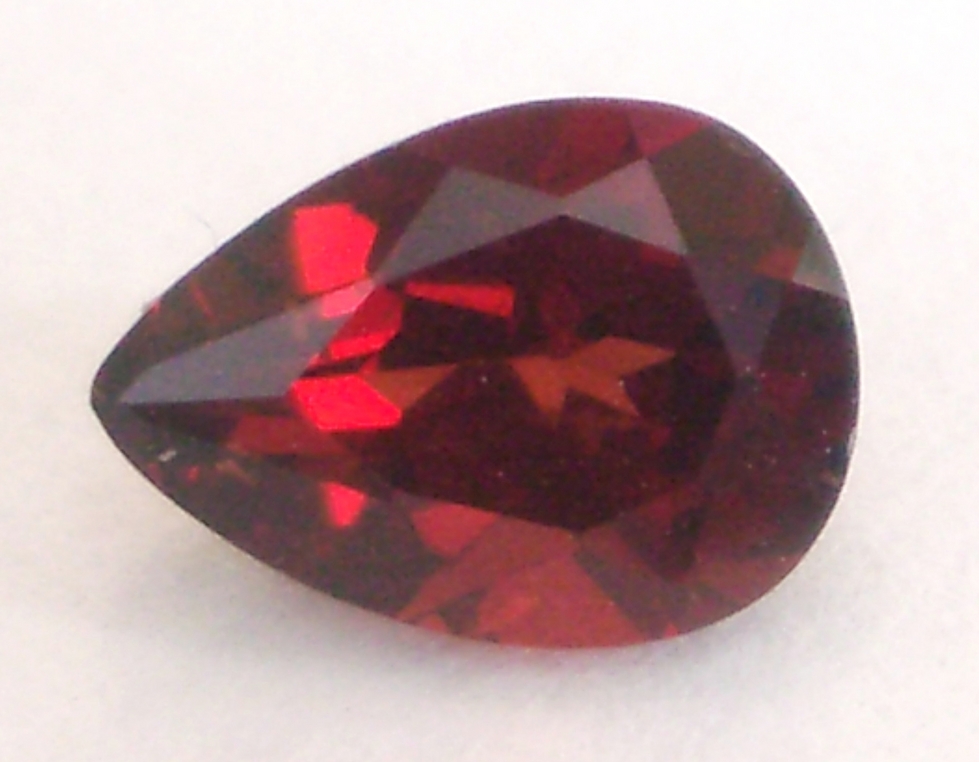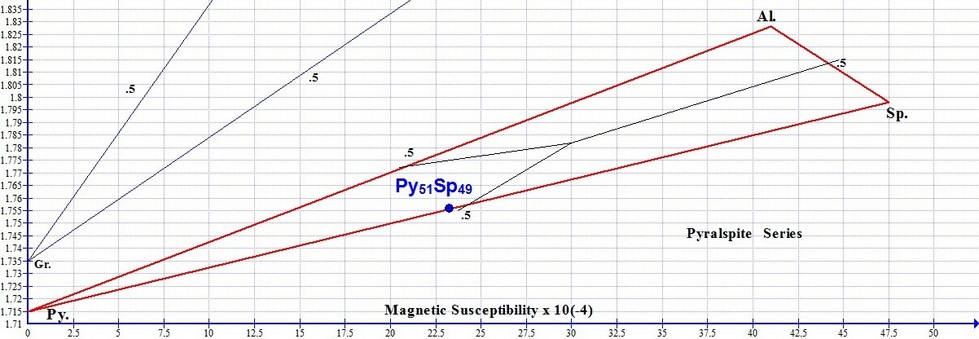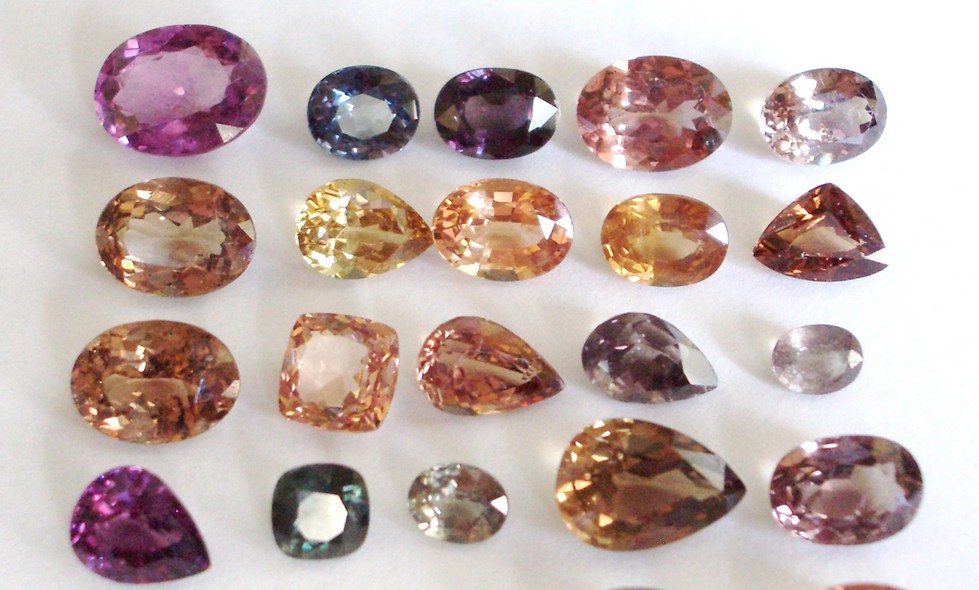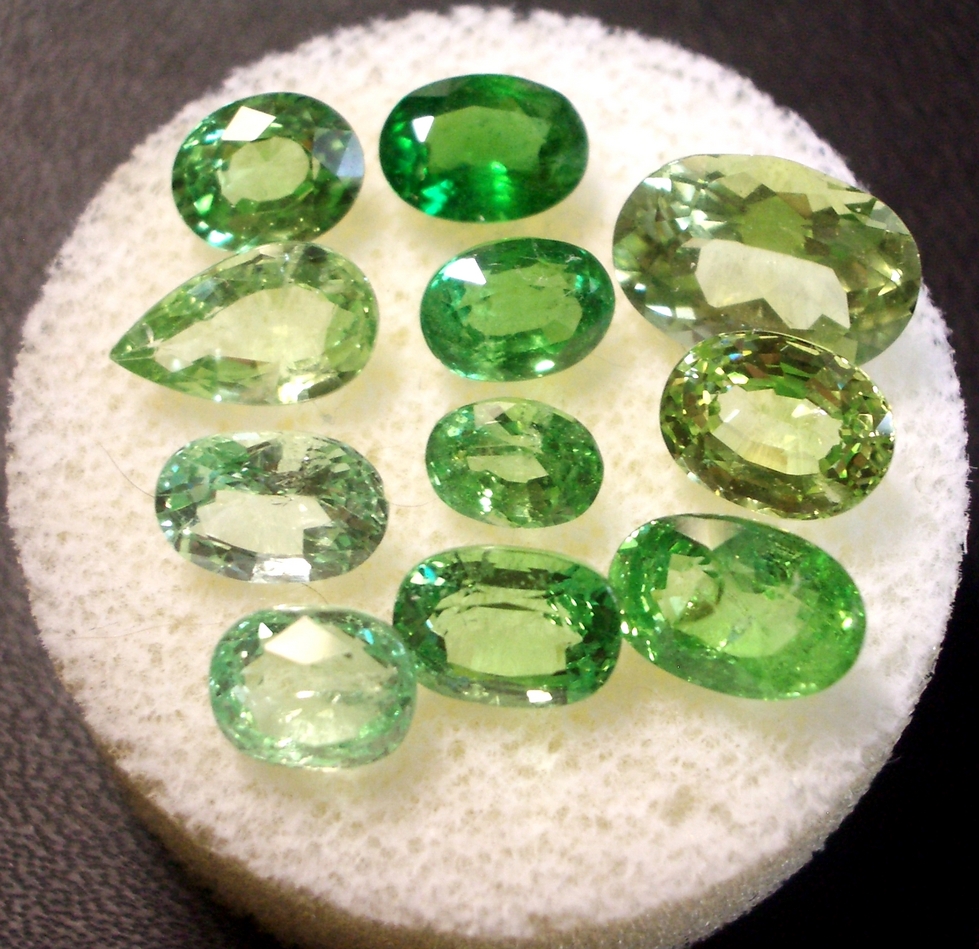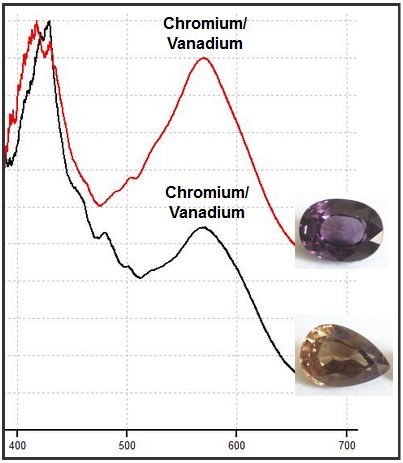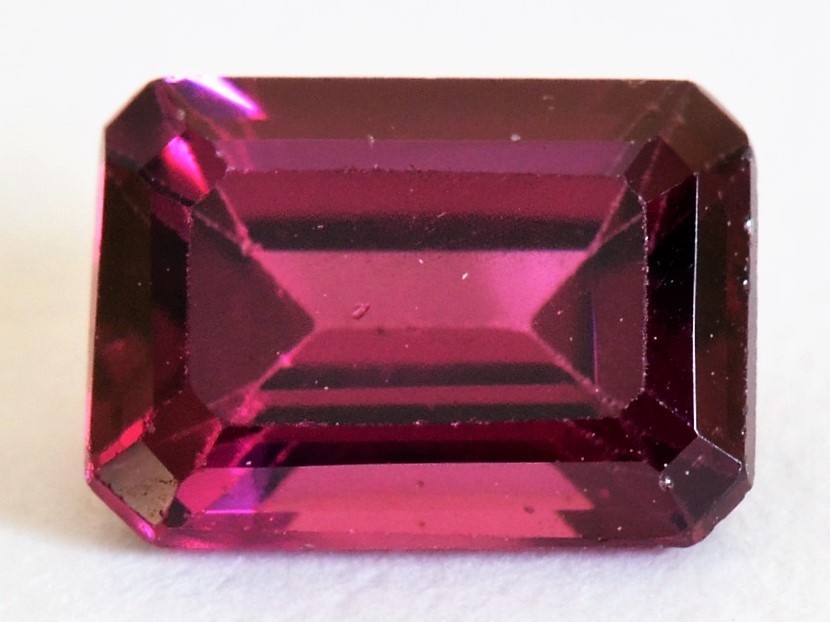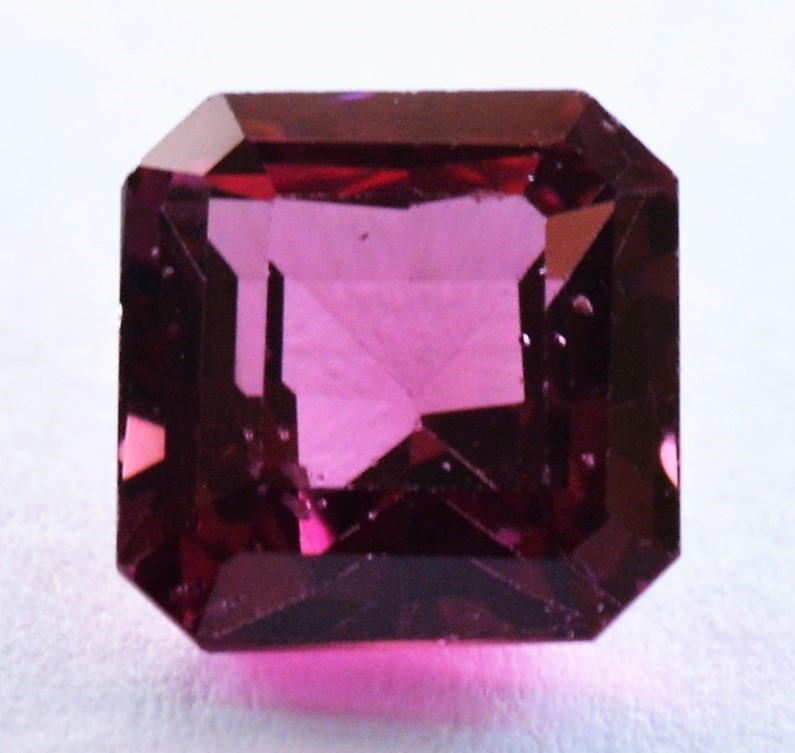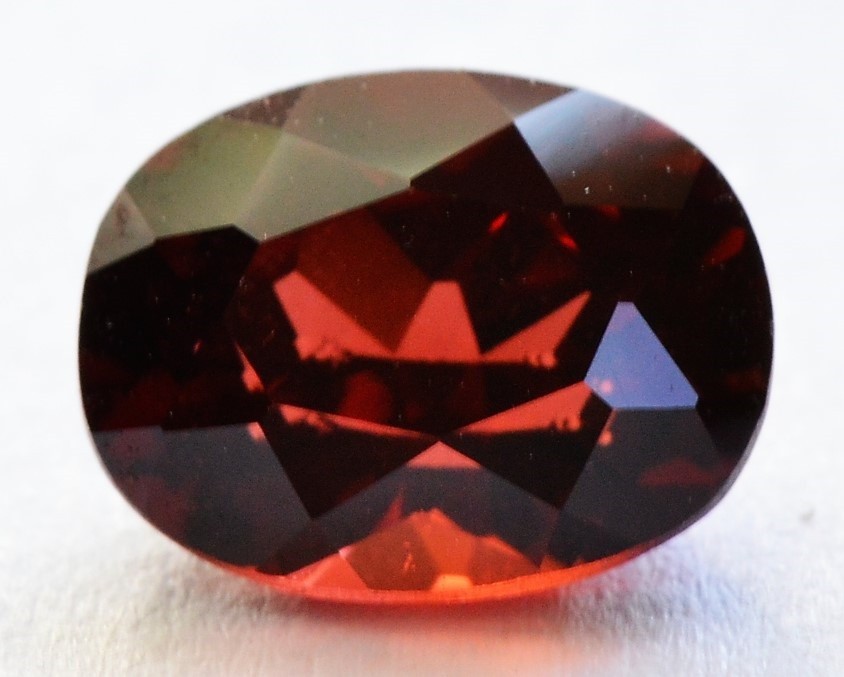Green Grossular Garnets
Gem dealers also commonly apply their own proprietary trade names based on the location of Garnet mining deposits, such as red "Mozambique" Garnet (determined by our investigation to be Standard Pyrope), red "Tanga" Garnet from Tanzania (determined to be Malaya), orangey red "Umbalite" from Tanzania (determined to be Malaya), brownish pink "Maralambo" Garnet from Madagascar (determined to be Pastel Pyrope), JTV's brownish pink "Massasi Bordeaux" Garnet from Tanzania (determined to be Malaya), pinkish orange "Mahenge" Garnet from Tanzania (determined to be Malaya) and orange Tangawizi Garnet from Tanzania (Malaya). The term "Malaya" itself is a trade name/variety name for any Pyralspite Garnet with unusual color and appearance.
"Cranberry" Garnet (Rhodolite)
Predicting Garnet Color: The Hoover method primarily measures iron and manganese in Garnets to determine the proportions of 2 or 3 end member Garnet components. The position of a graph point on a Hoover diagram predicts red color in Almandine Garnet and green color in Uvarovite Garnet, but the other 4 Garnet species show much more variation in color. Low concentrations of chromophores such as chromium, vanadium and charge transfer processes affect color but contribute little or nothing to magnetic susceptibility measurements.
Green Grossular Garnet is an example. The lowest magnetic susceptibility we can measure in green Grossular Garnets (under 20 SI) may have little if anything to do with the coloring agents chromium and vanadium from Uvarovite/Knorringite/Goldmanite. The magnetism we detect is likely due to entirely to iron (Fe3+) from the Andradite endmember.
Because the positioning of Garnet graph points on a Hoover diagram shows only the major components of a gem, it is not possible to accurately predict variations in Garnet color and color intensity by the location of those graph points when color is influenced by minor chemical components that are magnetically undetectable. Color variations may be due to small variations in chromium/vanadium content, and in some cases possibly to color processes such as intervalence charge transfer and even color centers. As illustrated by the 2 Pyralspite gems below, 2 Garnets of entirely different color can have the same proportions of the 3 end members (Pyrope, Almandine & Spessartine) and share exactly the same graph point location.
Color Change Garnets
"Mozambique" Garnet (Pyrope)
As purely descriptive terms, hybrid names can convey useful information about the extent of a Garnet's hybridization. But when detailed information about any individual Garnet's composition can readily be determined using a Hoover balance and the RIMS method, we don't need to invent new intermediate species names in order to classify Garnets. New hybrid names such as those adopted by GIA become obsolete. We can simply use the standard mineralogical classification system, which classifies an individual specimen by its primary end-member component (i.e. the species with the highest percentage composition). Our RIMS graph method determines the primary species by the trisection in which a gem's graph point falls. A Malaya Garnet known to contain 40% Pyrope, 35% Almandine and 25% Spessartine can be simply classified as a Pyrope Garnet, and additionally be referred to by the variety name Malaya.
"Champagne" Garnet (Andradite)
The olive-brown Garnet from Kenya and the purple Garnet from Bekily, Madagascar pictured above are both Color Change Pyropes, or as some prefer, Color Change Pyrope-Spessartines. Both gems change to pink color in incandescent light. They have nearly identical refractive indexes and magnetic susceptibilities. Both have the same major composition of 51% Pyrope and 49% Spessartine. But a slightly higher concentration of chromium/vanadium (which is magnetically undetectable) appears to be responsible for purple color in the oval gem. The shared graph point of these 2 gems is shown below, along with a spectrometer graph showing higher chromium/vanadium content in the purple Garnet.
Color Change Garnets with Identical Primary Composition
Garnets of Different Color Can Have the Same Primary Composition
As examples of mixing in small percentages, Green Grossulars such as Tsavorite and Merelani contain only about 5% Andradite (iron, Fe3+). Ions of vanadium (V3+) and chromium (Cr3+), which impart most of the bright green color found in these Grossulars, are derived from slight mixing with Goldmanite (V3+), Uvarovite (Cr3+) and Knorringite (Cr3+) Garnet species. That is to say, vanadium and chromium ions partially replace aluminum in the B site of the chemical formula for Grossular gems. The vanadium/chromium oxides that give green Grossulars most of their color make up less than 2% of the gem's weight, and can be as low as 0.1% or less.
© Kirk Feral 2011, All Rights Reserved. These materials may be duplicated for educational purposes only. No part of this website may be duplicated or distributed for profit, for commercial purposes, or for posting to another website without the expressed written consent of the copyright holder.
Idiochromatic or Allochromatic?
Pyrope and Grossular are considered allochromatic Garnet species (colored by impurities, and colorless when pure), and it is the allochromatic nature of these 2 species that is largely responsible for the tremendous color variations we see in gem Garnets. The strong colors and magnetic responses seen in allochromatic Pyrope and Grossular are due to mixing with idiochromatic Garnet species. The 4 idiochromatic gem Garnet species- Almandine, Spessartine, Andradite and Uvarovite- are self-colored and never completely colorless. In reality, every Garnet gem is a mixture of idiochromatic and allochromatic species components. The amount of mixing can sometimes be very small.
When we examine Garnets with a spectrometer, we see that chromium/vanadium is important to color in all varieties of the Pyrope Garnet species, with small amounts resulting in red, pink, purple, blue and green colors. Among Garnets containing significant amounts of Spessartine, manganese (Mn2+) primarily controls orange and yellow colors. In Garnets with substantial Almandine content, iron (Fe2+) contributes purplish red color.
Andradite Garnet colors such as brown, red and yellow are likely due to Fe2+-Ti4+ and/or Fe2+-Fe3+ charge transfer processes, while yellowish green color in Andradite (Demantoid variety) is the result of iron (Fe3+), and pure green or blue-green Demantoid is due primarily to chromium/vanadium.
Among Grossular Garnets, rich green colors are primarily the result of vanadium/chromium, although iron (Fe3+) can contribute yellowish green color. Orange colors in Grossular Garnet are caused primarily by traces of manganese (Mn2+) and possibly charge transfer involving manganese, while pink colors are caused by trivalent manganese (Mn3+). Iron (Fe3+) is often colorless (cryptic) in Grossulars, although charge transfer involving iron may contribute to red and orange color. More research is needed to provide a more complete picture of color in Garnets, especially regarding charge transfer processes.
Causes of Color
The orange color of Spessartine (Mn2+) and red color of Almandine (Fe2+) can be attributed to their primary species content, but a Garnet's color cannot always be attributed to the chromophores present in its primary end member. For example, the red color of Pyrope Garnet is not due to Pyrope content (Mg2+ magnesium). The red is derived from Almandine (Fe2+ iron) and Uvarovite/Knorringite/Goldmanite (Cr3+/V3+ chromium/vanadium).
Very small percentages of chromophores from other Garnet end members can dramatically affect color. As another example, the color of blue Color Change Garnet is not derived from its primary component Pyrope (Mg2+ magnesium), but rather from Spessartine (Mn2+ manganese) in combination with minor Goldmanite (V3+ vanadium) and Uvarovite (Cr3+ chromium) content (Schmetzer et al. 2009).
Garnet Names Based on Chemical Composition
Naming Garnets based on color is often a bad idea, as many different species and varieties of Garnet have the same body color. Professional gemologists prefer to rely on chemical composition to classify Garnets, but the composition for any individual Garnet gem as a mix of several Garnet species is rarely known or subject to discovery through lab testing. Even when composition is known, there is no consensus on the most appropriate naming or classification system. At times, gemologists simply ignore differences in composition between two gems in favor of common color, or common color phenomena such as "color change", when naming Garnets.
For example, gemologists sometimes refer to purple Almandines as Rhodolite Garnets, even though Almandine is a different species whose chemical composition can be very different from that of the reddish-purple variety of Pyrope (Rhodolite) of similar color. Gemologists also typically classify all Garnets that show color change as Color Change Garnets, failing to make any distinction as to whether the Color Change Garnet is primarily Pyrope or primarily Spessartine. We feel that using color or color phenomena as the primary parameter for classifying Garnets is a practice that perpetuates misunderstanding. Not only can color change gems of two different Garnet species appear identical, but also color change can occur in Garnet species and varieties that are not typically labelled as Color Change Garnets.
When attempting to name Garnets based on composition, some gemologists (Manson/Stockton, Hanneman) have created new species names that represent hybrid Garnets. Manson/Stockton proposed that gemologists recognize Pyrope-Almandine and Pyrope-Spessartine as additional species of gem Garnets that are intermediate in composition between the two end-member species Pyrope and Spessartine. These Garnets would have graph points located along the mid-section of the composition line that joins two end members. GIA does in fact now classify these two hybrids as distinct species, in addition to the 6 primary species of gem Garnets.
Pyrope-Almandine
51% Pyrope, 49% Almandine
Pyrope-Spessartine
34% Pyrope, 66% Spessartine
A Rainbow of Color in Garnets
Purple Rhodolite
Orange Spessartine
Garnet Names Based on Color
The mixing of Garnets in infinite combinations makes the naming of Garnets species and color varieties difficult. A variety name based on color variation can represent a useful gemological distinction, but trade names are often created by gem dealers only to enhance or maximize the market value of a gem. In the marketplace, it is a free-for-all when it comes to trade names for Garnets, most of which are based on minor peculiarities of color. Gem dealers want to appeal to buyers by using attractive names like "Cranberry" Garnet (purple-red Rhodolite), "Champagne" Garnet (yellow-brown Andradite), "Mandarin" Garnet (dark orange Spessartine or dark orange Hessonite) and "Fanta" Garnet (light orange Spessartine or Hessonite).
Confusion arises when dealers fail to provide the correct variety name or even species name for Garnets that are sold with exclusive trade names created specifically for the seller. Understandably, most dealers simply don't have a means for correct identification of Garnet. However, JTV has its own lab and does have the means, yet JTV takes extraordinary liberties with nomenclature, trademarking many new names for Garnets such as Mpito Color Change Garnet from Kenya, Vermehlo Garnet (Pyrope-Amlmandine) from Mozambique, and Serengeti Spessartite Garnet from Tanzania, all touted as new and unusual discoveries.
Such tailor-made trade names are generally not used by gemologists. But a few trade names based on origin (such as Tsavorite and Mali Garnet) or based on unique color and appearance (such as Rhodolite and Color Change Garnet) have over time become widely accepted in gemology as useful variety names for Garnets. Even time-honored gemstone names like Emerald (Beryl species), Sapphire and Ruby (Corundum species) are simply trade names for color varieties.
"Umbalite" Garnet (Malaya)
Naming Garnets by Color isn't Black & White
As we have shown, color alone is not a reliable parameter for identifying or classifying Garnets by species or variety. Due to the strong influence of trace chemistry, color does not necessarily predict primary composition. Conversely, primary composition often does not accurately predict color (or the phenomenon of color change). Similarly, absorption spectra as seen through a hand-held spectroscope are often not reliable indicators of composition.
GIA doesn't classify Garnets by variety at all, only by the primary species. All Garnet gems are complex, composed of several end member species. Hanneman proposes we recognize 7 different hybrid species in addition to the 6 primary end member species of gem Garnet. Hybrid species names such as Pyrope-Almandine and Pyrope-Spessartine that have been adopted by GIA may be useful. But if gemologists start relying on hybrid names to classify intermediate Garnet species, then they would also need to introduce the triple hybrid species Pyrope-Almandine-Spessartine to adequately classify many Pyralspites such as Malaya Garnets that contain significant amounts of all 3 end members in that series.
Such a triple-hybrid system could end up quite convoluted, as any particular Malaya, Rhodolite or Pastel Pyrope gem might be assigned to either the Pyrope-Almandine, Pyrope-Spessartine or Pyrope-Almandine-Spessartine hybrid species, depending upon the percentages of the end members in its composition.
Whether we attempt to delineate the exact boundaries that separate different Pyralspite species and varieties using quantitative measurements of magnetic susceptibility and refractive index (RIMS), or by relying on differences in color and appearance (or a combination of both), the distinctions we have adopted here in our own Garnet study are somewhat arbitrary. For instance, there may be little difference in color or composition between a high Rhodolite and a low Almandine, and the difference between a red Malaya and a Standard Pyrope, or a Rhodolite and a purple Pastel Pyrope, may in some instances be just small a variation in the concentration of chromium/vanadium that results in a slightly altered appearance.
But as gemologists, we must draw lines somewhere if we are to have any useful distinctions between the numerous variations in Garnet chemistry and color. The challenge is to arrive at a consensus as to which parameters are the most appropriate for separating and naming Garnets. When classifying gem Garnets by species name, this researcher suggests we limit the nomenclature to the 6 primary gem Garnet end members species recognized by mineralogists. In gemology, we also feel there is a need to accurately assign variety names to address the diversity of gems found within Garnet species, particularly within Pyrope, Grossular, and Andradite. Click on the link to view the Classification System that we advocate for species and varieties of gem Garnets.
Pink Malaya
Pinkish Purple Pastel Pyrope
"Fanta" Garnet (Spessartine)
Magnetism in Gemstones
An Effective Tool and Method for Gem Identification
© Kirk Feral

